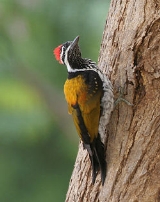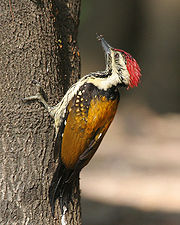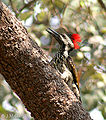
Black-rumped Flameback
Encyclopedia
The Black-rumped Flameback (Dinopium benghalense), also known as the Lesser Golden-backed Woodpecker or Lesser Goldenback, is a woodpecker
found widely distributed in South Asia
. It is one of the few woodpeckers that are seen in urban areas. It has a characteristic rattling-whinnying call and an undulating flight. It is the only golden-backed woodpecker with a black throat and black rump.
 The Black-rumped Flameback is a large species at 26–29 cm in length. It has a typical woodpecker shape, and the golden yellow wing coverts are distinctive. The rump is black and not red as in the Greater Flameback
The Black-rumped Flameback is a large species at 26–29 cm in length. It has a typical woodpecker shape, and the golden yellow wing coverts are distinctive. The rump is black and not red as in the Greater Flameback
. The underparts are white with dark chevron markings. The black throat finely marked with white immediately separates it from other golden backed woodpeckers in the Indian region. The head is whitish with a black nape and throat, and there is a greyish eye patch. Unlike the Greater Flameback it has no dark moustachial stripes.
The adult male has a red crown and crest. Females have a black forecrown spotted with white, with red only on the rear crest. Young birds are like the female, but duller.
Like other woodpeckers, this species has a straight pointed bill, a stiff tail to provide support against tree trunks, and zygodactyl feet, with two toes pointing forward, and two backward. The long tongue can be darted forward to capture insects.
Leucistic
birds have been recorded. Two specimens of male birds from the northern Western Ghats have been noted to have red-tipped feathers on the malar region almost forming a malar stripe. A female specimen from Lucknow has been noted to have grown an abnormal downcurved hoopoe-like bill.
is sometimes separated as tehminae (named after the wife of Salim Ali
) and is more olive above, has fine spots on the black throat and the wing-covert spots are not distinct. The southern Sri Lanka
n subspecies
D. b. psarodes has a crimson back and all the dark markings are blacker and more extensive. It hybridizes with the northern Sri Lankan race jaffnense which has a shorter beak. The Sri Lankan race psarodes is sometimes considered a distinct species although it is said to intergrade with jaffnense near Puttalam, Kekirawa and Trincomalee.
is found mainly on the plains going up to an elevation of about 1200m in Pakistan, India south of the Himalayas and east till the western Assam valley and Meghalaya, Bangladesh and Sri Lanka. It is associated with open forest and cultivation. They are often seen in urban areas with wooded avenues. It is somewhat rare in the Kutch and desert region of Rajasthan.
 This species is normally seen in pairs or small parties and sometimes joins mixed-species foraging flocks. They forage from the ground to the canopy. They feed on insects mainly beetle larvae from under the bark, visit termite mounds and sometimes feed on nectar. As they make hopping movements around branches, they often conceal themselves from potential predators. They adapt well in human-modified habitats making use of artificial constructions fallen fruits and even food scraps.
This species is normally seen in pairs or small parties and sometimes joins mixed-species foraging flocks. They forage from the ground to the canopy. They feed on insects mainly beetle larvae from under the bark, visit termite mounds and sometimes feed on nectar. As they make hopping movements around branches, they often conceal themselves from potential predators. They adapt well in human-modified habitats making use of artificial constructions fallen fruits and even food scraps.
The breeding season varies with weather and is between February and July. They frequently drum during the breeding season. The nest hole is usually excavated by the birds and has a horizontal entrance and descends into a cavity. Sometimes birds may usurp the nest holes of other birds. Nests have also been noted in mud embankments. The eggs are laid inside the unlined cavity. The normal clutch is three and the eggs are elongate and glossy white. The eggs hatch after about 11 days of incubation. The chicks leave the nest after about 20 days.
n these woodpeckers go by the generic name of kæralaa in Sinhala. In some parts of the island, it is also called kottoruwa although it more often refers to barbets. This bird appears in a 4.50 rupee
Sri Lanka
n postal stamp. It also appears in a 3.75 Taka postal stamp from Bangladesh.
Woodpecker
Woodpeckers are near passerine birds of the order Piciformes. They are one subfamily in the family Picidae, which also includes the piculets and wrynecks. They are found worldwide and include about 180 species....
found widely distributed in South Asia
South Asia
South Asia, also known as Southern Asia, is the southern region of the Asian continent, which comprises the sub-Himalayan countries and, for some authorities , also includes the adjoining countries to the west and the east...
. It is one of the few woodpeckers that are seen in urban areas. It has a characteristic rattling-whinnying call and an undulating flight. It is the only golden-backed woodpecker with a black throat and black rump.
Description

Greater Flameback
The Greater Flameback, Chrysocolaptes lucidus, also known as Greater Goldenback, Large Golden-backed Woodpecker or Malherbe's Golden-backed Woodpecker, is a woodpecker species...
. The underparts are white with dark chevron markings. The black throat finely marked with white immediately separates it from other golden backed woodpeckers in the Indian region. The head is whitish with a black nape and throat, and there is a greyish eye patch. Unlike the Greater Flameback it has no dark moustachial stripes.
The adult male has a red crown and crest. Females have a black forecrown spotted with white, with red only on the rear crest. Young birds are like the female, but duller.
Like other woodpeckers, this species has a straight pointed bill, a stiff tail to provide support against tree trunks, and zygodactyl feet, with two toes pointing forward, and two backward. The long tongue can be darted forward to capture insects.
Leucistic
Leucistic
Leucism is a condition characterized by reduced pigmentation in animals and humans. Unlike albinism, it is caused by a reduction in all types of skin pigment, not just melanin.- Details :...
birds have been recorded. Two specimens of male birds from the northern Western Ghats have been noted to have red-tipped feathers on the malar region almost forming a malar stripe. A female specimen from Lucknow has been noted to have grown an abnormal downcurved hoopoe-like bill.
Subspecies
The race in the arid northwestern India and Pakistan, dilutum, has pale yellow upperparts, a long crest and whiter underparts than the nominate race of the Gangetic plains. The upperparts have less spots. They prefer to breed in old gnarled tamarisks, Acacia and Dalbergia trunks. The nominate populations is found across India in the low elevations up to about 1000 m. Southern Peninsular form puncticolle has the throat black with small triangular white spots and the upper parts are a bright golden-yellow. The subspecies found in the Western GhatsWestern Ghats
The Western Ghats, Western Ghauts or the Sahyādri is a mountain range along the western side of India. It runs north to south along the western edge of the Deccan Plateau, and separates the plateau from a narrow coastal plain along the Arabian Sea. The Western Ghats block rainfall to the Deccan...
is sometimes separated as tehminae (named after the wife of Salim Ali
Salim Ali (ornithologist)
Sálim Moizuddin Abdul Ali was an Indian ornithologist and naturalist. Known as the "birdman of India", Salim Ali was among the first Indians to conduct systematic bird surveys across India and his bird books helped develop ornithology...
) and is more olive above, has fine spots on the black throat and the wing-covert spots are not distinct. The southern Sri Lanka
Sri Lanka
Sri Lanka, officially the Democratic Socialist Republic of Sri Lanka is a country off the southern coast of the Indian subcontinent. Known until 1972 as Ceylon , Sri Lanka is an island surrounded by the Indian Ocean, the Gulf of Mannar and the Palk Strait, and lies in the vicinity of India and the...
n subspecies
Subspecies
Subspecies in biological classification, is either a taxonomic rank subordinate to species, ora taxonomic unit in that rank . A subspecies cannot be recognized in isolation: a species will either be recognized as having no subspecies at all or two or more, never just one...
D. b. psarodes has a crimson back and all the dark markings are blacker and more extensive. It hybridizes with the northern Sri Lankan race jaffnense which has a shorter beak. The Sri Lankan race psarodes is sometimes considered a distinct species although it is said to intergrade with jaffnense near Puttalam, Kekirawa and Trincomalee.
Distribution and habitat
This flamebackFlameback
The flamebacks or goldenbacks are large woodpeckers which are resident breeders in tropical southern Asia. They derive their English names from their golden or crimson backs....
is found mainly on the plains going up to an elevation of about 1200m in Pakistan, India south of the Himalayas and east till the western Assam valley and Meghalaya, Bangladesh and Sri Lanka. It is associated with open forest and cultivation. They are often seen in urban areas with wooded avenues. It is somewhat rare in the Kutch and desert region of Rajasthan.
Behaviour and ecology

The breeding season varies with weather and is between February and July. They frequently drum during the breeding season. The nest hole is usually excavated by the birds and has a horizontal entrance and descends into a cavity. Sometimes birds may usurp the nest holes of other birds. Nests have also been noted in mud embankments. The eggs are laid inside the unlined cavity. The normal clutch is three and the eggs are elongate and glossy white. The eggs hatch after about 11 days of incubation. The chicks leave the nest after about 20 days.
In culture
The Sri LankaSri Lanka
Sri Lanka, officially the Democratic Socialist Republic of Sri Lanka is a country off the southern coast of the Indian subcontinent. Known until 1972 as Ceylon , Sri Lanka is an island surrounded by the Indian Ocean, the Gulf of Mannar and the Palk Strait, and lies in the vicinity of India and the...
n these woodpeckers go by the generic name of kæralaa in Sinhala. In some parts of the island, it is also called kottoruwa although it more often refers to barbets. This bird appears in a 4.50 rupee
Rupee
The rupee is the common name for the monetary unit of account in India, Sri Lanka, Nepal, Pakistan, Mauritius, Seychelles, Maldives, and formerly in Burma, and Afghanistan. Historically, the first currency called "rupee" was introduced in the 16th century...
Sri Lanka
Sri Lanka
Sri Lanka, officially the Democratic Socialist Republic of Sri Lanka is a country off the southern coast of the Indian subcontinent. Known until 1972 as Ceylon , Sri Lanka is an island surrounded by the Indian Ocean, the Gulf of Mannar and the Palk Strait, and lies in the vicinity of India and the...
n postal stamp. It also appears in a 3.75 Taka postal stamp from Bangladesh.

